Posted on Friday, February, 28th, 2020 in Announcements.
Content

Each account has an opening or carry-forward balance, and would record each transaction as either a debit or credit in separate columns, and the ending or closing balance. Once transactions are entered in relevant journals, this information is then posted to specific accounts which are most often grouped together in the form of ledgers. Ledger accounts almost always start out with an opening balance. For balance sheet accounts, the opening balance is usually the closing balance from the previous period. Income statement accounts start with an opening balance of zero because revenues and expenses should have been closed to retained earnings at the end of the prior period.
Within the ledger the transactions should ideally be balanced, i.e. both debit and credit entries should have a corresponding entry. In most ledgers, the debit entries are located on the left side of the T-shaped table, and credit entries are located on the right. Back then, in a business, in addition to the general journal, accountants used to keep different journals such as sales and purchases journals and paycheck journals. In the double-entry system, each financial transaction affects at least 2 different ledger accounts.
Businesses will use ledgers for their official books, not T-accounts. The general ledger is helpful in that a business can easily extract account and balance information. Is also known as the book of second entry or the principal book of accounts. The ledger contains the chart of accounts, which is the list of all names and account numbers in the ledger. The ledger is given special importance by auditors and must be “balanced,” where the total debits always equals the total credits.
Journals and ledgers are where business transactions are recorded in an accounting system. In essence, detail-level information for individual transactions is stored in one of several possible journals, while the information in the journals is then summarized and transferred to a ledger.
But in statement form, there are three money columns for writing debit and credit amount and also for balance. Despite advances in software technology, there will always be a need to record non-routine transactions in general journals, such as sales of assets, bad debt, and depreciation. Some organizations keep specialized journals, such as purchase journals or sales journals, that only record specific types of transactions. For every debit https://www.bookstime.com/ recorded in a ledger, there must be a corresponding credit, so that the debits equal the credits in the grand totals. General journal, as the name suggests, usually holds the record of such transaction that are not recorded in any other journal. In other words such transactions for which no separate journal is kept ended up in general journal. For example, sale or purchase of non-current asset, additional capital invested in the business.

Read on to find out more about them and how you can use them for your business. One of the most basic differences between the journal and ledger is when they are employed in the accounting process. The journal serves as the accounting book in which a transaction is first entered into the accounting system, with the transaction often referred to as the original entry. Later in the process, that same transaction journal vs ledger will be posted as an entry into the ledger, where that entry will be positioned in relation to other entries for purposes of evaluation and analysis. The general ledger contains the accounts used by the company to sort and store the amounts from all of the company’s transactions . The amounts and balances in the general ledger accounts are used to prepare the company’s financial statements.
10.5 Compute, interpret and compare return on investment and residual income. 10.2 Evaluate how responsibility accounting is used to help manage a decentralised organisation. Real account – an account that pertains to assets and liabilities. Coming from Engineering cum Human Resource Development background, has over 10 years experience in content developmet and management. In the journal, a portrayal should be composed to help the passage. Then again, in the ledger, there is no prerequisite for portrayal.